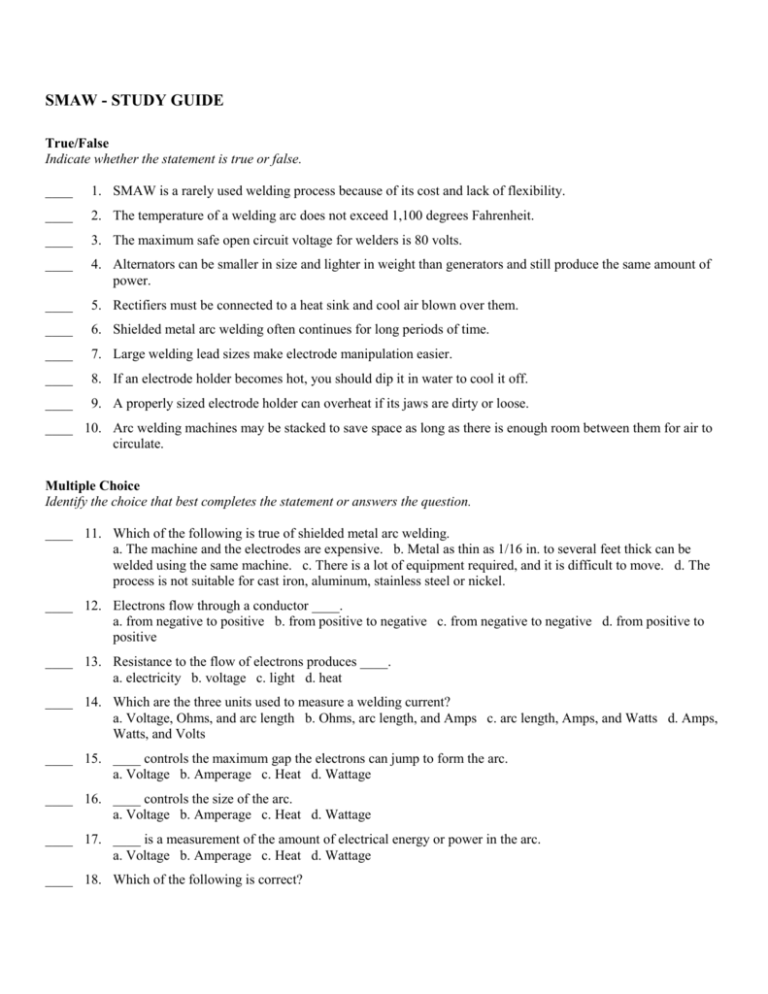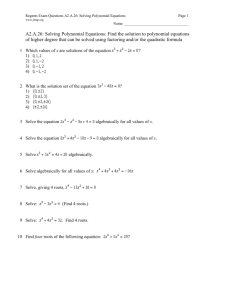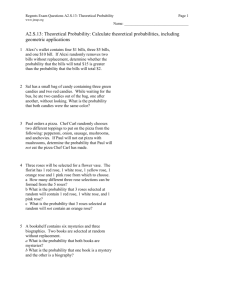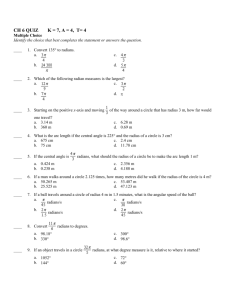SMAW - STUDY GUIDE True/False Indicate whether the statement is
advertisement

SMAW - STUDY GUIDE True/False Indicate whether the statement is true or false. ____ 1. SMAW is a rarely used welding process because of its cost and lack of flexibility. ____ 2. The temperature of a welding arc does not exceed 1,100 degrees Fahrenheit. ____ 3. The maximum safe open circuit voltage for welders is 80 volts. ____ 4. Alternators can be smaller in size and lighter in weight than generators and still produce the same amount of power. ____ 5. Rectifiers must be connected to a heat sink and cool air blown over them. ____ 6. Shielded metal arc welding often continues for long periods of time. ____ 7. Large welding lead sizes make electrode manipulation easier. ____ 8. If an electrode holder becomes hot, you should dip it in water to cool it off. ____ 9. A properly sized electrode holder can overheat if its jaws are dirty or loose. ____ 10. Arc welding machines may be stacked to save space as long as there is enough room between them for air to circulate. Multiple Choice Identify the choice that best completes the statement or answers the question. ____ 11. Which of the following is true of shielded metal arc welding. a. The machine and the electrodes are expensive. b. Metal as thin as 1/16 in. to several feet thick can be welded using the same machine. c. There is a lot of equipment required, and it is difficult to move. d. The process is not suitable for cast iron, aluminum, stainless steel or nickel. ____ 12. Electrons flow through a conductor ____. a. from negative to positive b. from positive to negative c. from negative to negative d. from positive to positive ____ 13. Resistance to the flow of electrons produces ____. a. electricity b. voltage c. light d. heat ____ 14. Which are the three units used to measure a welding current? a. Voltage, Ohms, and arc length b. Ohms, arc length, and Amps c. arc length, Amps, and Watts d. Amps, Watts, and Volts ____ 15. ____ controls the maximum gap the electrons can jump to form the arc. a. Voltage b. Amperage c. Heat d. Wattage ____ 16. ____ controls the size of the arc. a. Voltage b. Amperage c. Heat d. Wattage ____ 17. ____ is a measurement of the amount of electrical energy or power in the arc. a. Voltage b. Amperage c. Heat d. Wattage ____ 18. Which of the following is correct? a. Volts = Watts Amps b. Amps = Watts Volts c. Amps = Watts + Volts d. Watts = Volts Amps ____ 19. The amount of watts put into a weld per inch controls ____. a. the width and depth of the weld bead b. the size of the arc c. the temperature of the arc d. the size of the electrode required ____ 20. The shielded metal arc welding machine’s voltage output ____ as its current ____. a. decreases, decreases b. increases, increases c. increases, decreases d. decreases, increases ____ 21. Which of the following is true of open circuit voltage? a. It is the voltage at the arc during welding. b. It is the voltage at the electrode before striking an arc. c. It varies with arc length, type of electrode, type of current and polarity. d. The maximum safe voltage for welders is 40 volts. ____ 22. ____ can cause an arc to move during a weld. a. Alternating current b. Air currents c. Uneven flux lines d. Imperfections in the welding material ____ 23. A transformer with more turns of wire in the primary winding than in the secondary winding is known as a(n) ____. a. welding transformer b. low-amperage transformer c. step-down transformer d. high-voltage transformer ____ 24. The major classifications of welding machines are ____. a. multiple core, inversion, transformer b. multiple inversion, transformer core, and step-down c. multiplecoil, movable coil, and inverter d. magnetic core, movable coil, and transformer ____ 25. The ____ machine allows the selection of different current settings by tapping into the secondary coil at a different turn value. a. inverter b. transformer c. multiple-coil d. movable-coil ____ 26. ____ machines are adjusted by turning a handwheel that moves the internal parts closer together or farther apart. a. Movable coil b. Tap type c. Inverter d. Transformer ____ 27. In a standard welding transformer, the size of the iron core is determined by ____. a. the distance between the coils b. the length of time it takes for the magnetic field to build up and collapse c. the desired thickness of the weld bead d. the speed of the rotor ____ 28. A(n) ____ produces AC, and a(n) ____ produces DC. a. alternator, generator b. generator, alternator c. diode, alternator d. generator, diode ____ 29. In alternators the welding current is produced on the ____. a. brushes b. diode c. armature d. stator ____ 30. In generators the welding current is produced by the ____. a. brushes b. diode c. armature d. stator ____ 31. The heat produced by a rectifier ____. a. is a fire hazard b. reduces the power efficiency of the welding machine c. increases the power efficiency of the welding machine d. can be recycled in a heat sink to provide power to other machines ____ 32. A 20% duty cycle means that the machine can be used a total of ____ minutes out of every ten minutes at the maximum rated current. a. two b. six c. eight d. ten ____ 33. Welding cables made of aluminum wire must be ____ would be required for copper. a. one size smaller than b. the same size as c. one size larger than d. two sizes larger than ____ 34. Which of the following is true of work clamps? a. Power losses in the work clamp should be overlooked. b. Work clamps reduce welding efficiency. c. Work clamps must not clamp too tightly to the material. d. The clamp should be carefully touched occasionally to determine if it is hot. ____ 35. Which of the following is true of welding cables? a. They should be wrapped around the body to distribute the weight. b. The welding cables should be sufficiently long to reach the work station. c. Cables should never be installed overhead. d. Cables should be placed on the floor in aisles and walkways. Completion Complete each statement. 36. An electric current is the flow of ____________________. 37. ____________________ is a measure of electric pressure. 38. ____________________ is the measurement of the total number of electrons flowing. 39. ____________________ is the measurement of the amount of electrical energy or power in the arc. 40. The positive side of an electric arc is called a(n) ____________________. 41. The negative side of an electric arc is called a(n) ____________________. 42. In a(n) ____________________ welding machine the incoming power is changed from 60 cycles per second to several thousand cycles per second. 43. A(n) ____________________ allows a current to flow in one direction only. 44. The ______________________________ is the percentage of time a welding machine can be used continuously. 45. A 60% duty cycle means that out of any ten minutes, the machine can be used for a total of ____________________ minutes at the maximum rated current. Short Answer 46. Give an overview of the process of shielded metal arc welding. 47. Explain what magnetic flux lines are and how they may cause a wire to move when welding with very high amperages. 48. Explain how a welding transformer works. 49. Explain how generators and alternators work, and the similarities and differences between them. 50. Explain how an alternating welding current can be converted to a direct current. SMAW - STUDY GUIDE Answer Section TRUE/FALSE 1. 2. 3. 4. 5. 6. 7. 8. 9. 10. ANS: ANS: ANS: ANS: ANS: ANS: ANS: ANS: ANS: ANS: F F T T T F F F T T PTS: PTS: PTS: PTS: PTS: PTS: PTS: PTS: PTS: PTS: 1 1 1 1 1 1 1 1 1 1 REF: REF: REF: REF: REF: REF: REF: REF: REF: REF: 53 54 56 60 61-62 62 63 64 64 65 PTS: PTS: PTS: PTS: PTS: PTS: PTS: PTS: PTS: PTS: PTS: PTS: PTS: PTS: PTS: PTS: PTS: PTS: PTS: PTS: PTS: PTS: PTS: PTS: PTS: 1 1 1 1 1 1 1 1 1 1 1 1 1 1 1 1 1 1 1 1 1 1 1 1 1 REF: REF: REF: REF: REF: REF: REF: REF: REF: REF: REF: REF: REF: REF: REF: REF: REF: REF: REF: REF: REF: REF: REF: REF: REF: 53 53 53 53 53 54 54 54 54 55-56 56 56 57 57 57-58 59 59 60 60 60 62 62 63 65 66 MULTIPLE CHOICE 11. 12. 13. 14. 15. 16. 17. 18. 19. 20. 21. 22. 23. 24. 25. 26. 27. 28. 29. 30. 31. 32. 33. 34. 35. ANS: ANS: ANS: ANS: ANS: ANS: ANS: ANS: ANS: ANS: ANS: ANS: ANS: ANS: ANS: ANS: ANS: ANS: ANS: ANS: ANS: ANS: ANS: ANS: ANS: COMPLETION B A D D A B D D A D B C C C C A B A D C B A C D B 36. ANS: electrons PTS: 1 37. ANS: Voltage Volts REF: 53 PTS: 1 38. ANS: Amperage Amperes REF: 53 PTS: 1 39. ANS: Wattage Watts REF: 54 PTS: 1 40. ANS: anode REF: 54 PTS: 1 41. ANS: cathode REF: 54 PTS: 1 42. ANS: inverter REF: 54 PTS: 1 43. ANS: rectifier REF: 59 PTS: 1 44. ANS: duty cycle REF: 61 PTS: 1 45. ANS: six 6 REF: 62 PTS: 1 REF: 62 SHORT ANSWER 46. ANS: Shielded metal arc welding (SMAW) is a welding process that uses a flux-covered metal electrode to carry an electrical current. The current forms an arc across the gap between the end of the electrode and the work. The electric arc creates sufficient heat to melt both the electrode and the work. Molten metal from the electrode travels across the arc to the molten pool on the base metal, where they mix together. The end of the electrode and molten pool of metal is surrounded, purified, and protected by a gaseous cloud and a covering of molten flux produced as the flux coating of the electrode burns or vaporizes. As the arc moves away, the mixture of molten electrode and base metal solidifies and becomes one piece. At the same time, the molten flux solidifies forming a solid slag. Some electrode types produce heavier slag coverings than others. PTS: 1 REF: 53 47. ANS: When electrons flow they create lines of magnetic force that circle around the line of flow. Lines of magnetic force are referred to as magnetic flux lines. These lines space themselves evenly along a current-carrying wire. If the wire is bent, the flux lines on one side are compressed together, and those on the other side are stretched out. The unevenly spaced flux lines try to straighten the wire so that the lines can be evenly spaced once again. The force that they place on the wire is usually small. However, when welding with very high amperages, 600 amperes or more, the force may cause the wire to move. PTS: 1 REF: 56 48. ANS: A welding transformer uses the alternating current (AC) supplied to the welding shop at a high voltage to produce the low-voltage welding power. As electrons flow through a wire they produce a magnetic field around the wire. If the wire is wound into a coil the weak magnetic field of each wire is concentrated to produce a much stronger central magnetic force. Because the current being used is alternating or reversing each 1/120 of a second, the magnetic field is constantly being built and allowed to collapse. By placing a second or secondary winding of wire in the magnetic field produced by the first or primary winding a current will be induced in the secondary winding. The placing of an iron core in the center of these coils will increase the concentration of the magnetic field. PTS: 1 REF: 57 49. ANS: Generators and alternators both produce welding electricity from a mechanical power source. Both devices have an armature that rotates and a stator that is stationary. As a wire moves through a magnetic force field, electrons in the wire are made to move, producing electricity. In an alternator, magnetic lines of force rotate inside a coil of wire. An alternator can produce AC only. In a generator, a coil of wire rotates inside a magnetic field. A generator produces DC. It is possible for alternators to use diodes to change the AC to DC for welding. In generators, the welding current is produced on the armature and is picked up with brushes. In alternators, the welding current is produced on the stator, and only the small current for the electromagnetic force field goes across the brushes. Therefore, the brushes in an alternator are smaller and last longer. Alternators can be smaller in size and lighter in weight than generators and still produce the same amount of power. PTS: 1 REF: 60 50. ANS: Alternating welding current can be converted to direct current by using a series of rectifiers. A rectifier allows current to flow in one direction only. If one rectifier is added, it would be difficult to weld. A series of rectifiers, known as a bridge rectifier, can modify the alternating current. Rectifiers become hot as they change AC to DC. They must be attached to a heat sink and cooled by having air blown over them. The heat produced by a rectifier reduces the power efficiency of the welding machine. shows the amperage dial of a typical machine. Notice that at the same dial settings for AC and DC, the DC is at a lower amperage. The difference in amperage (power) is due to heat lost in the rectifiers. The loss in power makes operation with AC more efficient and less expensive compared to DC. A DC adapter for small AC machines is available from manufacturers. For some types of welding, AC does not work properly. PTS: 1 REF: 61-62








